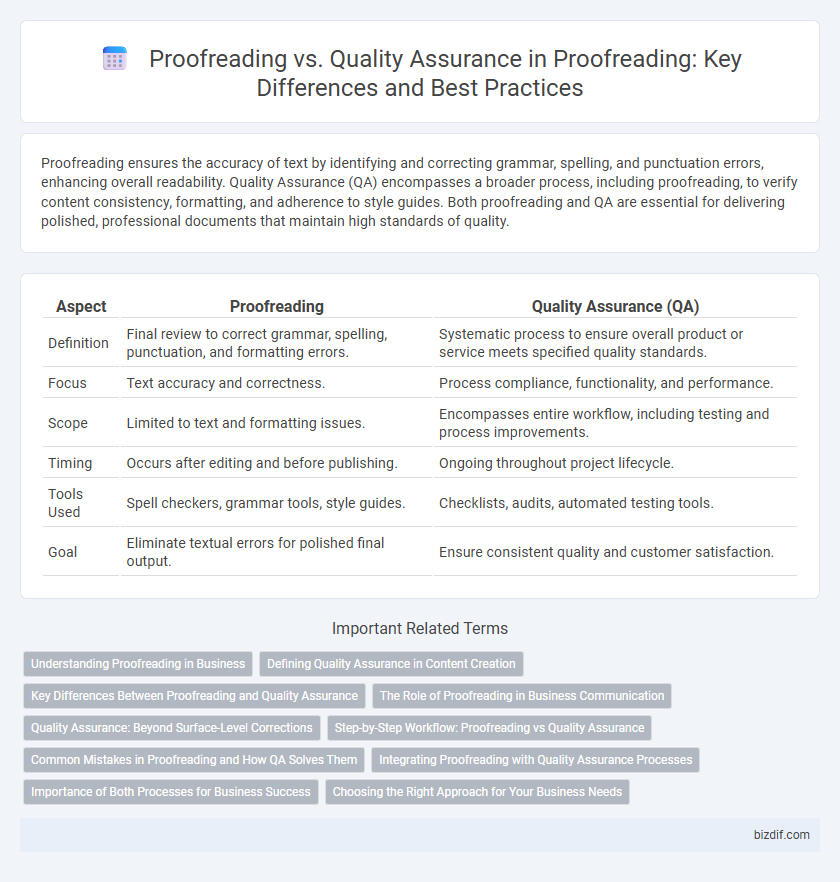Proofreading ensures the accuracy of text by identifying and correcting grammar, spelling, and punctuation errors, enhancing overall readability. Quality Assurance (QA) encompasses a broader process, including proofreading, to verify content consistency, formatting, and adherence to style guides. Both proofreading and QA are essential for delivering polished, professional documents that maintain high standards of quality.
Table of Comparison
| Aspect | Proofreading | Quality Assurance (QA) |
|---|---|---|
| Definition | Final review to correct grammar, spelling, punctuation, and formatting errors. | Systematic process to ensure overall product or service meets specified quality standards. |
| Focus | Text accuracy and correctness. | Process compliance, functionality, and performance. |
| Scope | Limited to text and formatting issues. | Encompasses entire workflow, including testing and process improvements. |
| Timing | Occurs after editing and before publishing. | Ongoing throughout project lifecycle. |
| Tools Used | Spell checkers, grammar tools, style guides. | Checklists, audits, automated testing tools. |
| Goal | Eliminate textual errors for polished final output. | Ensure consistent quality and customer satisfaction. |
Understanding Proofreading in Business
Proofreading in business ensures the accuracy and clarity of documents by identifying and correcting spelling, grammar, and punctuation errors, thereby enhancing professionalism and credibility. Unlike quality assurance, which encompasses broader processes to maintain overall product or service standards, proofreading specifically targets textual integrity and correctness. Effective proofreading reduces costly miscommunication and reinforces consistent brand messaging across corporate communications.
Defining Quality Assurance in Content Creation
Quality assurance in content creation involves systematically evaluating written material to ensure accuracy, clarity, and consistency before publication. It encompasses not only proofreading for grammar and spelling errors but also verifying factual correctness, formatting standards, and adherence to brand guidelines. This comprehensive process helps maintain high content quality and enhances audience trust.
Key Differences Between Proofreading and Quality Assurance
Proofreading involves carefully checking text for spelling, grammar, punctuation, and formatting errors to ensure accuracy and readability. Quality assurance encompasses a broader process, including reviewing content for consistency, compliance with style guides, functionality, and user experience across various stages of production. Key differences lie in proofreading's focus on text correctness, while quality assurance addresses overall quality standards and product performance.
The Role of Proofreading in Business Communication
Proofreading ensures business communication is free from spelling, grammar, and punctuation errors, enhancing clarity and professionalism. It plays a critical role in maintaining brand credibility and preventing misunderstandings in corporate documents, marketing materials, and client correspondence. By catching minor mistakes before publication, proofreading supports quality assurance processes aimed at delivering polished and accurate business content.
Quality Assurance: Beyond Surface-Level Corrections
Quality assurance in proofreading extends beyond surface-level corrections by systematically evaluating the entire content for consistency, accuracy, and adherence to style guidelines. It involves comprehensive checks on grammar, punctuation, formatting, and factual accuracy to ensure the final document meets professional standards. Implementing quality assurance processes reduces errors, enhances readability, and maintains the integrity of the text throughout publication.
Step-by-Step Workflow: Proofreading vs Quality Assurance
Proofreading involves a detailed, sentence-level review focusing on correcting grammar, punctuation, and spelling errors to ensure textual accuracy. Quality Assurance (QA) encompasses a broader, systematic evaluation process that includes functional tests, compliance checks, and performance assessments to guarantee the overall quality of a product or content. The step-by-step workflow in proofreading prioritizes linguistic precision, while QA integrates multiple layers of review to validate both content integrity and operational standards.
Common Mistakes in Proofreading and How QA Solves Them
Common mistakes in proofreading include overlooking typographical errors, inconsistent formatting, and missed grammatical issues that can impact the clarity and professionalism of a document. Quality Assurance (QA) addresses these problems by implementing systematic checks and standardized processes that catch errors early and maintain content consistency. Advanced QA tools use automated algorithms and human oversight to enhance accuracy, ensuring error-free and polished final outputs.
Integrating Proofreading with Quality Assurance Processes
Integrating proofreading with quality assurance processes enhances overall content accuracy and consistency by systematically identifying and correcting errors before publication. Combining linguistic precision from proofreading with the systematic checks of quality assurance ensures higher standards in product deliverables, reducing costly revisions. Leveraging tools like automated checkers alongside manual review optimizes error detection and alignment with brand guidelines.
Importance of Both Processes for Business Success
Proofreading ensures error-free written communication by meticulously checking grammar, spelling, and punctuation, which enhances brand professionalism and customer trust. Quality assurance encompasses a broader scope, including process optimization and product consistency, delivering reliable and high-quality outputs that meet customer expectations. Together, proofreading and quality assurance drive business success by safeguarding reputation, reducing costly mistakes, and improving overall product and service quality.
Choosing the Right Approach for Your Business Needs
Proofreading ensures error-free, polished text by focusing on grammar, spelling, and punctuation, ideal for businesses aiming to perfect their written content. Quality assurance (QA) encompasses a broader scope, including process evaluation and product consistency, essential for maintaining overall standards in complex projects. Selecting between proofreading and QA depends on your business priorities--opt for proofreading to enhance textual accuracy, or QA to uphold comprehensive quality control across operations.
Proofreading vs Quality Assurance Infographic

 bizdif.com
bizdif.com